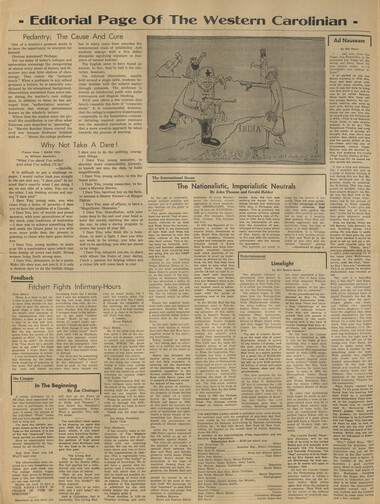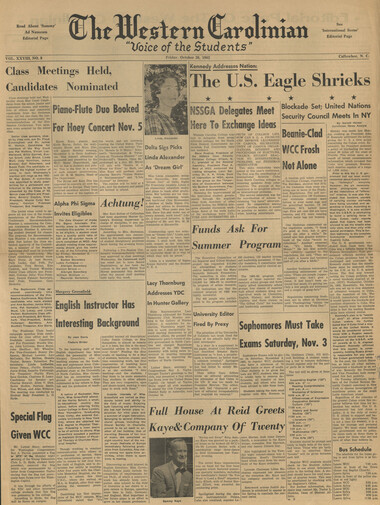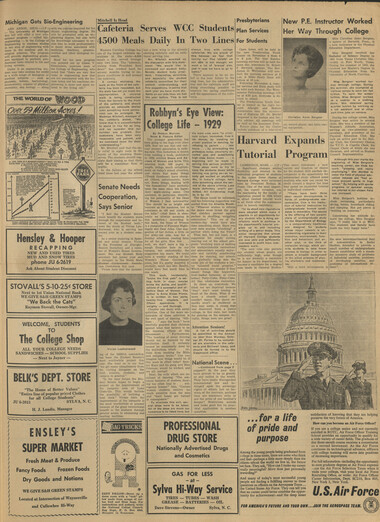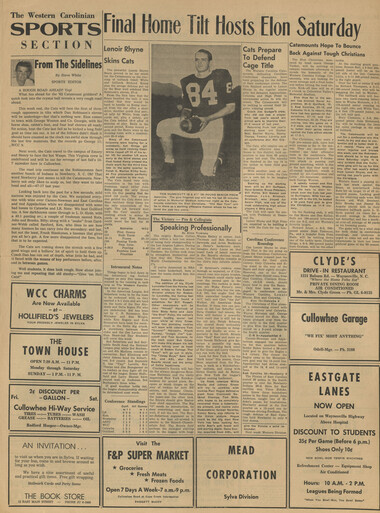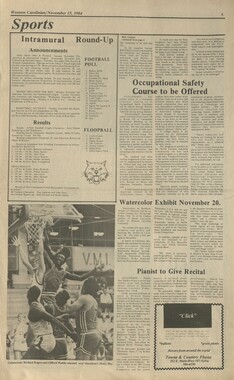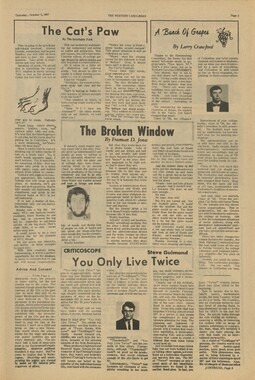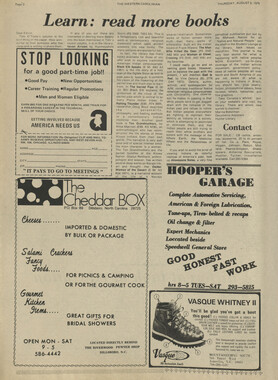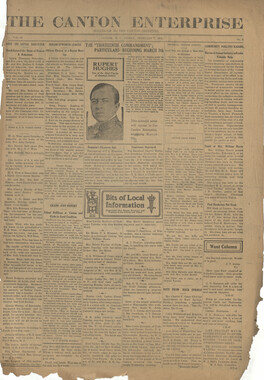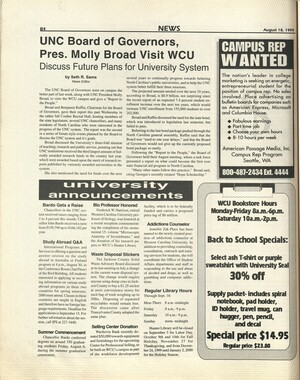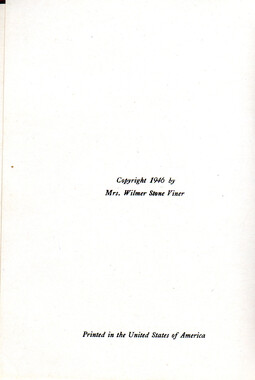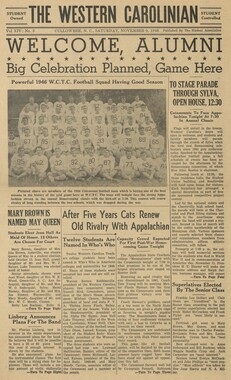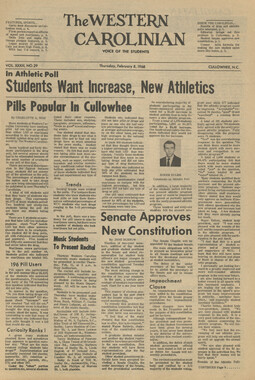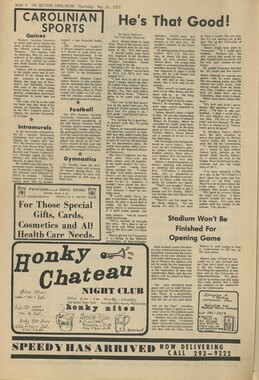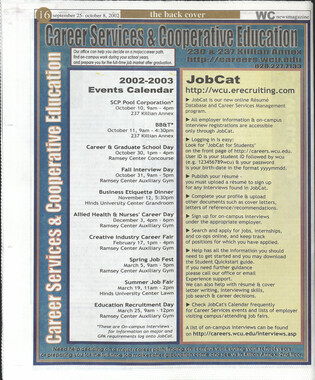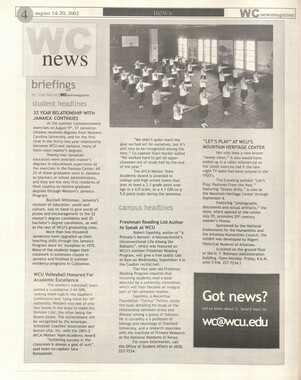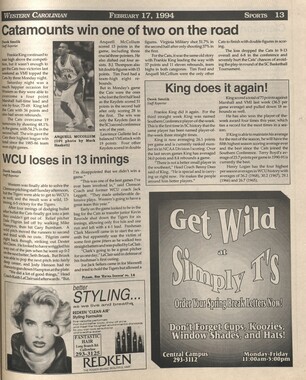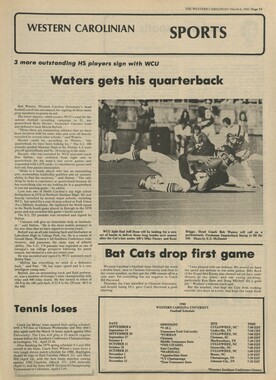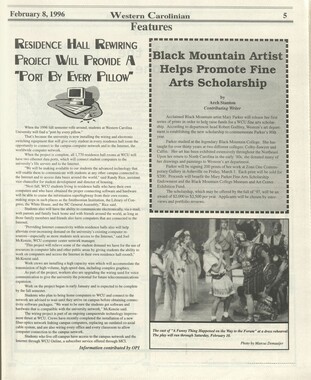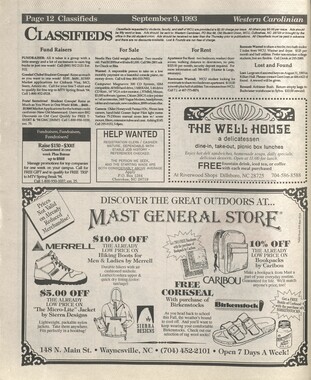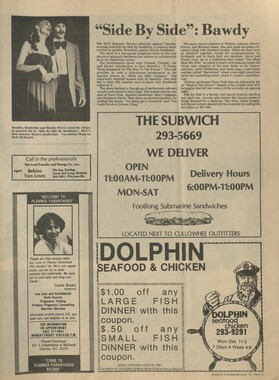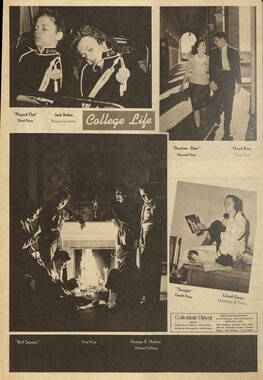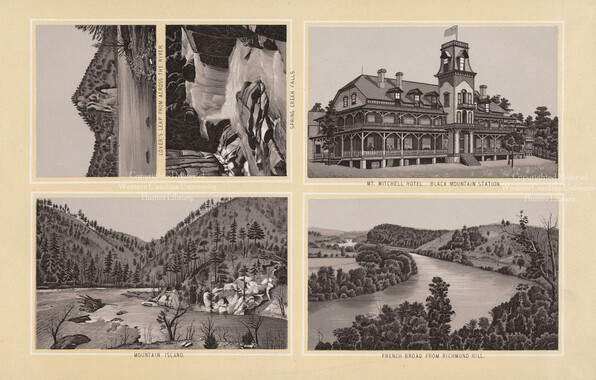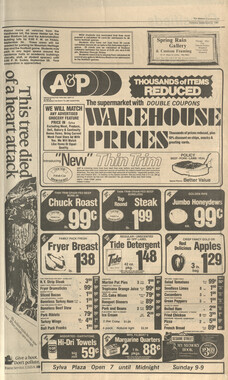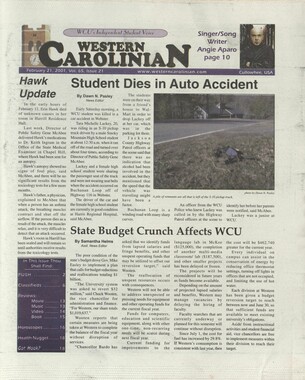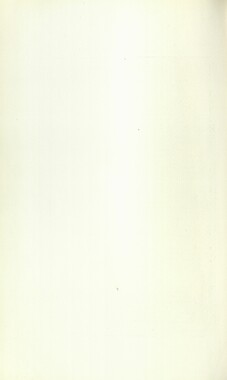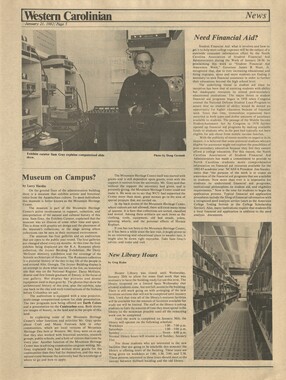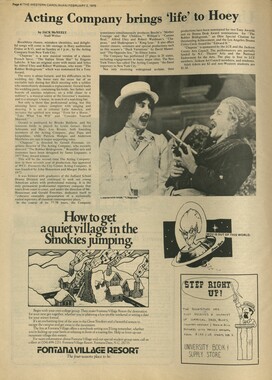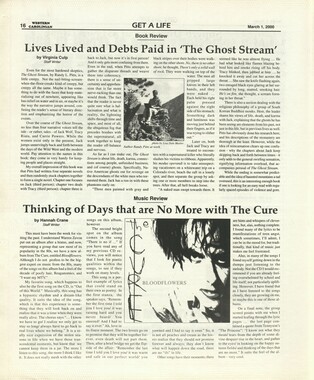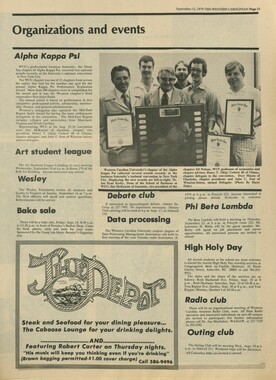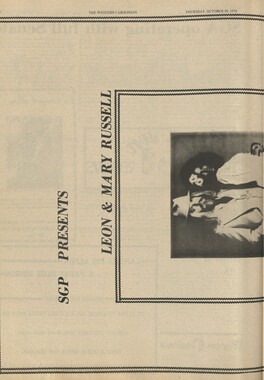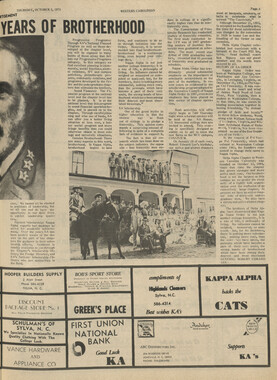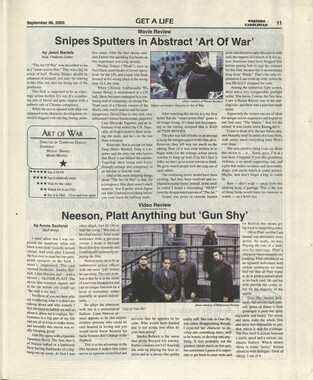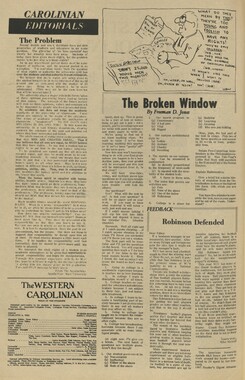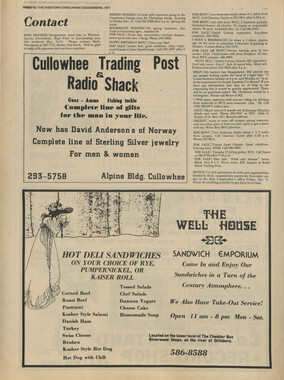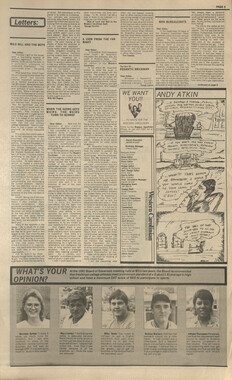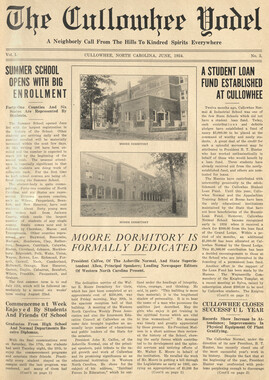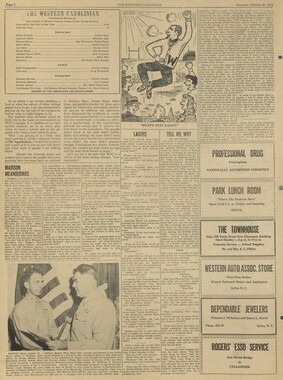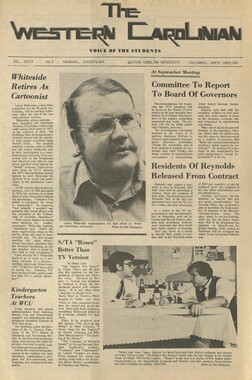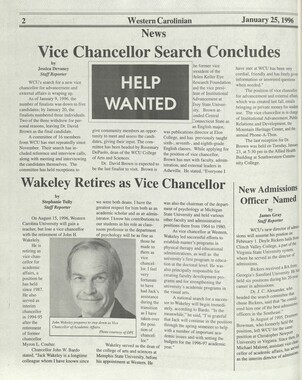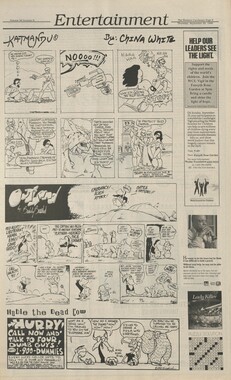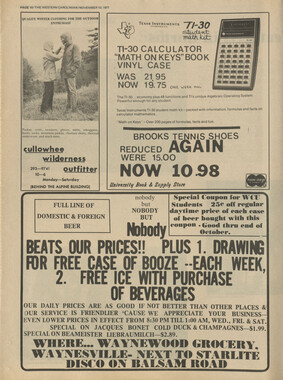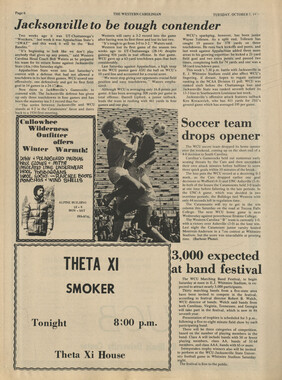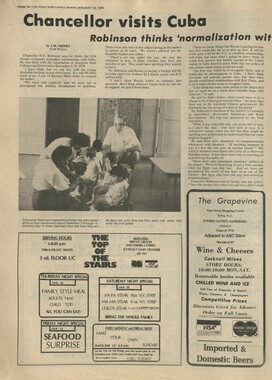Western Carolina University (20)
View all
- Canton Champion Fibre Company (2308)
- Cherokee Traditions (293)
- Civil War in Southern Appalachia (165)
- Craft Revival (1942)
- Great Smoky Mountains - A Park for America (2767)
- Highlights from Western Carolina University (430)
- Horace Kephart (941)
- Journeys Through Jackson (154)
- LGBTQIA+ Archive of Jackson County (26)
- Oral Histories of Western North Carolina (314)
- Picturing Appalachia (6772)
- Stories of Mountain Folk (413)
- Travel Western North Carolina (160)
- Western Carolina University Fine Art Museum Vitreograph Collection (129)
- Western Carolina University Herbarium (92)
- Western Carolina University: Making Memories (708)
- Western Carolina University Publications (2283)
- Western Carolina University Restricted Electronic Theses and Dissertations (146)
- Western North Carolina Regional Maps (71)
- World War II in Southern Appalachia (131)
University of North Carolina Asheville (6)
View all
- Western Carolina College (199)
- Western Carolina Teachers College (239)
- Western Carolina University (1792)
- Allanstand Cottage Industries (0)
- Appalachian National Park Association (0)
- Bennett, Kelly, 1890-1974 (0)
- Berry, Walter (0)
- Brasstown Carvers (0)
- Cain, Doreyl Ammons (0)
- Carver, George Washington, 1864?-1943 (0)
- Cathey, Joseph, 1803-1874 (0)
- Champion Fibre Company (0)
- Champion Paper and Fibre Company (0)
- Cherokee Indian Fair Association (0)
- Cherokee Language Program (0)
- Crittenden, Lorraine (0)
- Crowe, Amanda (0)
- Edmonston, Thomas Benton, 1842-1907 (0)
- Ensley, A. L. (Abraham Lincoln), 1865-1948 (0)
- Fromer, Irving Rhodes, 1913-1994 (0)
- George Butz (BFS 1907) (0)
- Goodrich, Frances Louisa (0)
- Grant, George Alexander, 1891-1964 (0)
- Heard, Marian Gladys (0)
- Kephart, Calvin, 1883-1969 (0)
- Kephart, Horace, 1862-1931 (0)
- Kephart, Laura, 1862-1954 (0)
- Laney, Gideon Thomas, 1889-1976 (0)
- Masa, George, 1881-1933 (0)
- McElhinney, William Julian, 1896-1953 (0)
- Niggli, Josephina, 1910-1983 (0)
- North Carolina Park Commission (0)
- Osborne, Kezia Stradley (0)
- Owens, Samuel Robert, 1918-1995 (0)
- Penland Weavers and Potters (0)
- Rhodes, Judy (0)
- Roberts, Vivienne (0)
- Roth, Albert, 1890-1974 (0)
- Schenck, Carl Alwin, 1868-1955 (0)
- Sherrill's Photography Studio (0)
- Smith, Edward Clark (0)
- Southern Highland Handicraft Guild (0)
- Southern Highlanders, Inc. (0)
- Stalcup, Jesse Bryson (0)
- Stearns, I. K. (0)
- Thompson, James Edward, 1880-1976 (0)
- United States. Indian Arts and Crafts Board (0)
- USFS (0)
- Vance, Zebulon Baird, 1830-1894 (0)
- Weaver, Zebulon, 1872-1948 (0)
- Western Carolina University. Mountain Heritage Center (0)
- Whitman, Walt, 1819-1892 (0)
- Wilburn, Hiram Coleman, 1880-1967 (0)
- Williams, Isadora (0)
- 1920s (57)
- 1930s (69)
- 1940s (114)
- 1950s (66)
- 1960s (314)
- 1970s (599)
- 1980s (406)
- 1990s (379)
- 2000s (195)
- 2010s (83)
- 1600s (0)
- 1700s (0)
- 1800s (0)
- 1810s (0)
- 1820s (0)
- 1830s (0)
- 1840s (0)
- 1850s (0)
- 1860s (0)
- 1870s (0)
- 1880s (0)
- 1890s (0)
- 1900s (0)
- 1910s (0)
- 2020s (0)
- Jackson County (N.C.) (2282)
- Appalachian Region, Southern (0)
- Asheville (N.C.) (0)
- Avery County (N.C.) (0)
- Blount County (Tenn.) (0)
- Buncombe County (N.C.) (0)
- Cherokee County (N.C.) (0)
- Clay County (N.C.) (0)
- Graham County (N.C.) (0)
- Great Smoky Mountains National Park (N.C. and Tenn.) (0)
- Haywood County (N.C.) (0)
- Henderson County (N.C.) (0)
- Knox County (Tenn.) (0)
- Knoxville (Tenn.) (0)
- Lake Santeetlah (N.C.) (0)
- Macon County (N.C.) (0)
- Madison County (N.C.) (0)
- McDowell County (N.C.) (0)
- Mitchell County (N.C.) (0)
- Polk County (N.C.) (0)
- Qualla Boundary (0)
- Rutherford County (N.C.) (0)
- Swain County (N.C.) (0)
- Transylvania County (N.C.) (0)
- Watauga County (N.C.) (0)
- Waynesville (N.C.) (0)
- Yancey County (N.C.) (0)
- Newsletters (510)
- Publications (documents) (1773)
- Aerial Photographs (0)
- Aerial Views (0)
- Albums (books) (0)
- Articles (0)
- Artifacts (object Genre) (0)
- Bibliographies (0)
- Biography (general Genre) (0)
- Cards (information Artifacts) (0)
- Clippings (information Artifacts) (0)
- Crafts (art Genres) (0)
- Depictions (visual Works) (0)
- Design Drawings (0)
- Drawings (visual Works) (0)
- Envelopes (0)
- Facsimiles (reproductions) (0)
- Fiction (general Genre) (0)
- Financial Records (0)
- Fliers (printed Matter) (0)
- Glass Plate Negatives (0)
- Guidebooks (0)
- Internegatives (0)
- Interviews (0)
- Land Surveys (0)
- Letters (correspondence) (0)
- Manuscripts (documents) (0)
- Maps (documents) (0)
- Memorandums (0)
- Minutes (administrative Records) (0)
- Negatives (photographs) (0)
- Newspapers (0)
- Occupation Currency (0)
- Paintings (visual Works) (0)
- Pen And Ink Drawings (0)
- Periodicals (0)
- Personal Narratives (0)
- Photographs (0)
- Plans (maps) (0)
- Poetry (0)
- Portraits (0)
- Postcards (0)
- Programs (documents) (0)
- Questionnaires (0)
- Scrapbooks (0)
- Sheet Music (0)
- Slides (photographs) (0)
- Songs (musical Compositions) (0)
- Sound Recordings (0)
- Specimens (0)
- Speeches (documents) (0)
- Text Messages (0)
- Tintypes (photographs) (0)
- Transcripts (0)
- Video Recordings (physical Artifacts) (0)
- Vitreographs (0)
- The Reporter, Western Carolina University (510)
- WCU Students Newspapers Collection (1744)
- A.L. Ensley Collection (0)
- Appalachian Industrial School Records (0)
- Appalachian National Park Association Records (0)
- Axley-Meroney Collection (0)
- Bayard Wootten Photograph Collection (0)
- Bethel Rural Community Organization Collection (0)
- Blumer Collection (0)
- C.W. Slagle Collection (0)
- Canton Area Historical Museum (0)
- Carlos C. Campbell Collection (0)
- Cataloochee History Project (0)
- Cherokee Studies Collection (0)
- Daisy Dame Photograph Album (0)
- Daniel Boone VI Collection (0)
- Doris Ulmann Photograph Collection (0)
- Elizabeth H. Lasley Collection (0)
- Elizabeth Woolworth Szold Fleharty Collection (0)
- Frank Fry Collection (0)
- George Masa Collection (0)
- Gideon Laney Collection (0)
- Hazel Scarborough Collection (0)
- Hiram C. Wilburn Papers (0)
- Historic Photographs Collection (0)
- Horace Kephart Collection (0)
- Humbard Collection (0)
- Hunter and Weaver Families Collection (0)
- I. D. Blumenthal Collection (0)
- Isadora Williams Collection (0)
- Jesse Bryson Stalcup Collection (0)
- Jim Thompson Collection (0)
- John B. Battle Collection (0)
- John C. Campbell Folk School Records (0)
- John Parris Collection (0)
- Judaculla Rock project (0)
- Kelly Bennett Collection (0)
- Love Family Papers (0)
- Major Wiley Parris Civil War Letters (0)
- Map Collection (0)
- McFee-Misemer Civil War Letters (0)
- Mountain Heritage Center Collection (0)
- Norburn - Robertson - Thomson Families Collection (0)
- Pauline Hood Collection (0)
- Pre-Guild Collection (0)
- Qualla Arts and Crafts Mutual Collection (0)
- R.A. Romanes Collection (0)
- Rosser H. Taylor Collection (0)
- Samuel Robert Owens Collection (0)
- Sara Madison Collection (0)
- Sherrill Studio Photo Collection (0)
- Smoky Mountains Hiking Club Collection (0)
- Stories of Mountain Folk - Radio Programs (0)
- Venoy and Elizabeth Reed Collection (0)
- WCU Gender and Sexuality Oral History Project (0)
- WCU Mountain Heritage Center Oral Histories (0)
- WCU Oral History Collection - Mountain People, Mountain Lives (0)
- Western North Carolina Tomorrow Black Oral History Project (0)
- William Williams Stringfield Collection (0)
- Zebulon Weaver Collection (0)
- College student newspapers and periodicals (1769)
- African Americans (0)
- Appalachian Trail (0)
- Artisans (0)
- Cherokee art (0)
- Cherokee artists -- North Carolina (0)
- Cherokee language (0)
- Cherokee pottery (0)
- Cherokee women (0)
- Church buildings (0)
- Civilian Conservation Corps (U.S.) (0)
- Dams (0)
- Dance (0)
- Education (0)
- Floods (0)
- Folk music (0)
- Forced removal, 1813-1903 (0)
- Forest conservation (0)
- Forests and forestry (0)
- Gender nonconformity (0)
- Great Smoky Mountains National Park (N.C. and Tenn.) (0)
- Hunting (0)
- Landscape photography (0)
- Logging (0)
- Maps (0)
- Mines and mineral resources (0)
- North Carolina -- Maps (0)
- Paper industry (0)
- Postcards (0)
- Pottery (0)
- Railroad trains (0)
- Rural electrification -- North Carolina, Western (0)
- School integration -- Southern States (0)
- Segregation -- North Carolina, Western (0)
- Slavery (0)
- Sports (0)
- Storytelling (0)
- Waterfalls -- Great Smoky Mountains (N.C. and Tenn.) (0)
- Weaving -- Appalachian Region, Southern (0)
- Wood-carving -- Appalachian Region, Southern (0)
- World War, 1939-1945 (0)
- Text (2283)
- MovingImage (0)
- Sound (0)
- StillImage (0)
Western Carolinian Volume 28 Number 08
Item
Item’s are ‘child’ level descriptions to ‘parent’ objects, (e.g. one page of a whole book).
-
-
- Editorial Page Of The Western Carolinian - Pedantry: The Cause And Cure One of a student's greatest needs is to have the opportunity to interpret for himself. Obvious statement? Perhaps. Yet too many of today's colleges and universities encourage the categorizing of almost every phase of history and literature into neat little shelves of chronology. Then comes the "pedantic touch." When a professor in any school prepares a lecture, he is naturally conditioned by his educational background. Observations assembled from notes taken during the teacher's own college days, in addition to those he has salvaged from "authoritative sources," constitute that strange phenomenon known as the scholarly lecture. Where does the student enter the picture? His contribution is too often what Emerson once described as "parroting," i.e. "Harriet Beecher Stowe started the civil war because Professor Nebbish said so . .." Hence, the college professor has in many cases been awarded the unwarranted cloak of infallibility. And students emerge with a five dollar sheepskin signifying exposure to four years of canned hearsay. The English seem to have found an answer. In fact, they've had it for centuries: Seminars. Via informal discussions, usually held around a single table, students become familiar with the subject matter through symposia. The professor is merely an intellectual guide who curbs irrelevances and illogical thinking. WCC now offers a few courses that faintly resemble this form of "corporate study." It is recommended, however, that the college's respective departments —especially in the humanities—consider initiating required senior seminars into the standard curriculum in order that a more creative approach be taken towards the process of learning. Why Not Take A Dare! (Taken from I DARE YOU by William Danforth) "What I've dared I've willed; And what I've willed, I'll do!" —Melville. It is difficult to put a challenge on paper. I would rather look you straight in the eye and say, "I dare you!" In my mind that's exactly what I am doing. I am on one side of a table. You are on the other. I am looking across and saying "I dare you!" I Dare You, young man, you who come from a home of poverty—I dare you to have the qualities of a Lincoln. I Dare You, heir of wealth and proud ancestry, with your generations of worthy stock, your traditions of leadership ■—I dare you to achieve something that will make the future point to you with even more pride than the present is pointing to those who have gone before you. I Dare You, young mother, to make your life a masterpiece upon which that little family of yours can build. Strong women bring forth strong men. I Dare You, debutante, to be a queen. Make life obey you, not you it. It is only a shallow dare to do the foolish things. I dare you to do the uplifting, courageous things. I Dare You, young executive, to shoulder more responsibility joyously, to launch out into the deep, to build magnificently. I Dare You, young author, to win the Nobel prize. I Dare You, young researcher, to become a Microbe Hunter. I Dare You, barefoot boy on the farm, to become a Master Farmer—A Hunger Fighter. I Dare You, man of affairs, to have a "Magnificent Obsession." I Dare You, Grandfather, with your roots deep in the soil and your head a- bove the crowd, catching the rays of the sun, to plan a daring program to crown the years of your life. I Dare You, who think life is humdrum, to start a fight. I dare you who are weak to be strong; you who are dull to be sparkling; you who are slaves to be kings. I Dare You, whoever you are, to share with others the fruits of your daring. Catch a passion for helping others and a richer life will come back to you! Feedback Fitchett Fights Infirmary-Hours Dear Editor There is a time to get up, a time to go to classes, a time to open your mouth—to eat, a time to open the mouth to spout lingo, a time to keep the mouth shut (because of the consequences that may follow), a time to go to bed, a time to do this and that, etc. These, we are forced to adhere to most of the time. But the big question that spurts from the mouth of the student of WCC, "Is this the time to be sick?" Or should it be "Can there be a specific time to get sick?" To these questions I hope there are some consequences to follow. I was awakened early Sunday morning by the hack- hack coughing of someone in the room. Not until I sniffed my nose and tossed my throbbing head did I realize that I was the nuisance with the big, bad, head, chest and everything else cold. As everyone knew, it was a dreary rainy Sunday. Into this mess I trudged down to the infirmary to get some "wonder drugs." Much to my sore throat (I wasn't really surprised) I found the door locked. Even though it was 10:00 and the "office hours" don't start until 1:00 on Sundays, I felt sure someone would answer my knocking since this was an emergency (the sign said only for emergencies), But, I was turned away in distress. Can there not be something done about the "office hours" in the infirmary? I don't want to pick on the nurses since they have helped me ever so much lately, but I can't tell exactly when I'm going to get sick. Yes, I made it through the remainder of the morning, but how long must the sick be kept waiting until it is time to be doctored? Until that time, I remain, Bruce Fitchett On Campus In The Beginning By Jim Cloninger A recent statement by a PE Dept. head mentioned the fact that fraternities may not be able to participate in the intramural program next year. It seems that several of the individual "Floor" teams did not have enough men and had to drop out. I'm sure the athletic program means quite a bit to the frats on the campus. It is one of the few "approved" functions carried on around here. Such an unnecessary move should immediately be boycotted by all involved. will find an Air Force ad which broadcasts, "For a Life of Pride and Purpose." I just heard the President's speech concerning Cuber. What a parallel. You talk, I'll shake. And then there was LR. Wait'll next year. The basketball team seems to be shaping up again this year. Wijth the original five back, which, i'f you didn't know were Carolinas Conference champs last year, and the addition of high school sensation John Brintnall, look for the Cats to be tough a- gain this year. The cheerleaders were exposed to a very hazardous incident this past week end. The college station wagon which they drove to Hickory blew a tire, but miraculously no one was injured. Maybe we need to hire a "VICE PRESIDENT IN CHARGE OF TIRE INSPECTION." Elsewhere in this sheet you The Living End The freshman coed sat quietly in the Dean's office. She had applied for a withdrawal slip only two weeks after the start of school. "How do you know you want to drop out, you've only been here two weeks?'' the Dean inquired. "I come here to be went with and I ain't been," answered the girl. And in Cullowhee, that is absolutely, The Living End. ^^mm§^®( ■/£ ,fu~ t£/}'#A/gp #e*j WAtikWCS '■iy>X^M<X^X^y>Xv:iri>Ai i"*",^"^^M***>AA**""""''"'' M.MMjuuyM.MMmw«iMMMi.l,M.Myuu. n nnn ,,„ n nr _r „nnnnnnnnn The International Scene The Nationalistic, Imperialistic Neutrals By John Thomas and Gerald Holder Dear Editor, We of the radio club know that quite a few of the students, are, at present, unable to receive our college radio station, WWOO. We know that most of you would like to be able to hear us, and a number of you have personally expressed this desire. We want you to know that we are doing our utmost in trying to have your college radio station repaired and put into the condition so that everyone on campus might hear double "O." The improvements that we have outlined have been in the hands of the college engineering staff for some time, and we are hopeful that soon something will be done. Please be patient and bear with us through this difficulty which we hope to have corrected shortly. Thank you for your support, Joe Sloop, President Radio Club Dear Students, It has recently come to the attention of The Western Carolinian that a few of the clubs on campus are dissatisfied with our reporting service. We run we are told, news about only two or three of the organizations on campus. This is regrettably true, but we plead "Not Guilty" to a charge of favoritism. We do not have a special club reporter—and I believe everybody will admit that if we did, he could not possibly attend meetings of every club on campus. Club news which is printed in The Carolinian is submitted by the club which makes the news, and we happily print it. Press deadline is 7:00 on Tuesday evening, and news In the age of intercontinental ballistic missiles and nuclear war is it possible for any location on the globe to be neutral? Two great idealogies confront the world: That of communism and democracy, commonly referred to as East and West. Since the termination of WW II, the diplomacy of both East and West hsa been an attempt to coax the other nations of the world into their camps. This is being done by financial, military and technical assistance. The two main countries that are doing this are the USSR and the US. Perhaps of the leading neutrals in the world today Prime Minister Nehru of India is the most outstanding. Since Nehru's ascent to power, as the result of the assi- nation of Mahatma Ghandi, he has advocated a policy of neutrality. India has received millions of dollars in aid from both the USSR and the US. Yet he refuses to commit himself solely to either side. Russia has supplied India with both arms and technical assistance. Recently US engineers and capital completed a multi-million dollar hydroelectric dam on the Ganges River. In the past, India has suffered from famine at which time both East and West have supplied wheat to the starving multitudes. Being neutral is defined as "not taking part on either side in a conflict; not aiding either or any of the states at war." Nehru has followed the neutral policy in accepting aid but fails miserably in carrying out the diplomacy of the neutralists. He was in constant opposition to the Korean conflict. During the Suez crisis Nehru came out in support of Nassar's unlawful seizure of the canal. By the power of international law the canal was still the property of Great Britain as the result of a treaty drawn up between Great Britain and Egypt in 1889. At this point the neutrals not only overstepped the boundaries of neutralism but sanctioned a direct breach of international law. Nehru sanctioned his provocation on grounds of British imperialism. After the U2 incident in 1960 Nehru openly renounced the US action as an act of aggression against Russia. The over-all philosophy of the neutrals is to create a neutral block between the East and West and thereby preserve world peace. Prime Minister Nehru stated that neutralism is the hope of mankind. Among these so- called neutrals are India, Yugoslavia, the Middle East and should be turned in to a member of the news or feature staff. We encourage all club "reporters" to earn their officer status and accept this ivitation to contribute. Robbyn Morrow News and Feature Editor Indonesia. At every Western move the neutrals scream aggression or more emphatically IMPERIALISM. Then they in turn use NATIONALISM as a coverup for imperialism. For example, Dutch New Guinea, Pan-Arabism and Goa. In 1961 the Republic of Indonesia, a member of the neutral block, threatened to take Dutch New Guinea by force if necessary. Violence erupted and Indonesian paratroopers landed in Dutch New Guinea and were thoroughly trounced. Sukarno used rabid speeches of nationalism to cover up imperialism as defined by the neutrals. He felt that they have the right to take what they want, Dutch New Guinea, yet the US had no right to insure itself with reconnaissance missions over Russia. Any pro-Western move is defined as imperialism while any neutral move is nationalism? Neutralism sounds weak with the sound of marching men in the background. In the Middle East the big movement afoot is Pan-Arabism. The leader and leading advocate of this movement is Egypt's Nasser. In 1956, under the pretense of nationalism, Nasser illegally seized the Suez and threw the world on the brink of war. He called upon all Arab nations for support and sought their membership in the United Arab Republic. This UAR was the basis for Nasser's dream of an Arab empire with Nassed as leader. From the beginning, Pan- Arabism has been a united effort to destroy Israel. Here again the idea of Nationalism being used to cover up for an eventual imperialistic move of aggression on Israel. The Arab states continually threaten the state of Israel on the pretense of nationalism. The Pan-Arab leaders state that there is no room in the Middle East for the Jews. Is this neutralism? Early in 1961 the Chinese completed their conquest of Tibet. The Chinese armies massed on India's northern border. Alas, the lion was watchig the mouse. Yet, the mouse turned and destroyed little Goa, a Portugese possession. This is probably the most uneven military contest since Germany's rape of Poland in 1939. As in 1939, there was no declaration of war, only the execution of prearranged military plans which easily succomed the province of Goa. Again, as it always is, the case with the neutrals, nationalism was the excuse for aggression. The neutrals are quick to judge the big powers of the world. They are even quicker to take advantage of their diplomatic situation, they play both ends against the middle. The neutrals are neutral so long as it benefits their position. They then will become aggressive and imperialistic when this line of action is to their benefit. Neutralism is a Utopian ideal in a very modern world. If East and West go to the brink of war who will the various "neutral" powers —Continued to page 3 Entertainment Limelight by Bill Shawn Smith The greatest cultural a chievement ever known in the United States is nearing completion in New York City. It is called the Lincoln Center for the Performing Arts. The project began in 1955 when both the Metropolitan Opera Company and the New York Philharmonic Orchestra were looking for new homes. These two performing companies decided to combine. Other institutions, such as the famed Julliard School of Music, joined them, and thus began the Lincoln Center for the Performing Arts. The site of Lincoln Center is on the west side of upper Manhattan Island. It covers 13 city blocks (14 acres), and the land, plus its buildings, was bought from the City of New York at a public auction for a small fee of $7,500,000! The over-all cost of the project will be over $142 million: 40 million of which will come from federal, state and city governments. The first problem for the creators of the project, headed by John D. Rockefeller III was to evacuate the 1,100 families living in buildings covering the 13 blocks. The residents didn't want out! It took many months of pleading, but finally the old brownstones gave way to culture, Buildings crumbled THE WESTERN CAROLINIAN is published every week during the academic year with the exception of mid-term and final exam weeks by the students of Western Carolina College. Represented for National Advertising by National Advertising Service, Inc.. 18 East 50th Street, New York 22, New York. Offices are located on the second floor of Joyner Building, phone 293-2312. A member of the Intercollegiate Press Association and the Carolina Press Association. Subscription Rate — $2.00 per school year John Streetman III Editor Jim Cloninger Business Mgr., Senior Columnist Mrs. Ruth K. Nelson Advisor Roberta Morrow News and eFature Editor Billie Jean Barnes C°PV Editor Joan Davis, Robert Davis, Bruce Fitchett, Jean Harlow, Susan Holmes, Jerry Lance, Pat Melton, Annette Yarbrough Reporters Steve White Sports Editor David Howell, Ken Hux, Ernie Trubiano, Jim Wade, Howard White Sports Reporters Herb Quarles Photographer Jim Callahan, Gerald Holder, Jac Murphy, Bill Raoul, Bill Shawn Smith, John Thomas Columnists Howard Perkins Cartoonist Jean Canno, Marie Mathis Typists Bob Parrish Circulation Manager Bill Raoul Layout Supervisor into what resembeld a war- torn city. Out of these ruins rose what composer William Schumann calls, ". . . the greatest symbol of the performing arts in centuries." At the groundbreaking ceremonies on May 14, 1959, President Eisenhower blessed the land: "Here will occur a true interchange of the fruits of national culture. From this will develop a growth that will spread to the corners of the earth, bringing with it the kind of human message that only individuals, not governments, can transmit." By the time the Lincoln Center is completed in 1966, it will be the home of five buildings plus a band shell for outdoor concerts. The Philharmonic Hall opened last month to what LIFE magazine called ". . . the nation's most elegant musical event of the century." Other building include the New York State Theatre for ballet and opera to open in 1964; the Metropolitan Opera House (1965); a library-museum and Vivian Beaumont Theatre for drama (1964); and the Julliard School of Music (1966). In order that performing halls might be made as perfect as possible a team of experts toured more than 30 of Europe's finest concert stages. One of these halls, the new, air conditioned Metropolitan Opera House, will be at the head of a giant plaza and will have a facade composed of 10-story high columns separated by glass walls. The Lincoln Center Repertory Company will be the first of its kind in the United States and will compete with Europe's Old Vic Company and Comed^a Francaise. The "Rep" company Is to be headed by Elia Kazan and Robert Whitehead; its first season of 33 weeks will open in October, 1963. All hail the Lincoln Center for the Performing Arts! A- merican culture is taking a momentous step up the artistic ladder. Most critics agree that when the endeavor is complete, "New York will be the center of the cultural renaissance of twentieth century America." Ad Nauseam By Bill Raoul ". . . and now, from Las Vegas (via Knoxville) is the renowned Las Vegas hit ,the Swing and Sway Band for blue haired ladies, with Cleveland's own Sammy D Kaye." It all started on one cool March morning in 1910. Mrs. Kaye had been great with child for many months, and now it was her time to bring into this world a son, and he was to be called Sammy. What could Mrs. Kaye call him except Sammy, for certainly nothing else went so well with Swing and Sway! She saw great things in the future for her son. One day he would play the Paramount in NYC. (That is not National Youth Club, in case anyone mistook it to be so.) The Paramount Theatre, last rung on the ladder of success, all thought. But, alas, there was another step visible and that was the gaudy glitter of the sin-ridden soul-less city of wickedness, vicious Vegas. Sammy was not daunted by this, and grabbing his trophy (High Hurdle Champ of Rocky Springs Hi) he leaped his way across the country. It was a long and tiresome trip. I mention this only as a point of interest because it was during this era that Mr. Kaye developed one of the greatest boons to mankind, the K-Ration. This was done purely by accident, when the base-player dropped his fiddle into the East fork of the Chastity River (oops, Ches- tasee) and in the process of removing it, Kaye casually commented, "I can't give you more than one of those a day." Little did he know that that great utterance would someday feed the world. Alas, we digress. When we left Sammy (ne> Samuel) he was hurdling across the plains. He was deep in cattle country of days gone by, and the band decided it would be good to set up and gig a bit. The petit vocalist sang his shimmering "Danny Boy," and was promptly shot at by a cattle poke carrying all of the latest John McCormack records in his saddle bag, which, with the final, "Danny Boy I love you," shattered. This is no answer to whether McCormack was cracked or not. "My, isn't it a beautiful day; a fine day?" said Kaye. With pococurante parlance a violin was mysteriously found, and the air was filled with silver throated tones of placid Puccini's Un Bel Di. However, after the poco- allegro giusto con moto, just before the andante alia breve allegretto (I don't have the slightest idea what sounds impressive), the lush sounds impressive.) The lush thrush hit a note that wasn't there. This note was higher than the ordinary Civil Defense whistle, but lower than most dog beckoners. Actually, it was just the right note to penetrate the left ear of the wrong cow. Poor Bossy, she tried to make sweet milk, but when it curdles 'en sac,' something must be done. With painful and slightly sour brown eyes the cow headed poco-allegro for the vocalist. In the rush, the thrush was crushed, and the herd slowly faded into the distance. The r e m a i n ing members of the band were heard humming "Thanks for the mammaries." Kaye finally reached Las Vegas. To his great shock, he found that his booking had been filled by a youngster called Beiderbeck. Kaye looked at his engagement book and found that he couldn't read it. Borrowing Miff Mole's glasses (Mole wore big glasses), he deciphered the message to be Cullowhee, and not Vegas. This distressed Kaye no end. In fact, no end was not his only problem; no one had heard of Cullowhee, which was not unusual for this epoch in American History. "Hey," called Kaye. "Hi," answered his drummer, and immediately all knew that Cullowhee was just off the Hi-way in the Hay country. The troupe went to Sylva, in the "middle of the most;" therefore a good starting place. Much to their surprise, the Democrats had heard of Mrs. Buchanan. Catching Harry the Happy Bus, Kaye arrived in Cullowhee just in time to be feted, immunized, and shown the accoustically beautiful concert hall. All was readied, and the students flocked in; some were swung, and a few swayed.
Object
Object’s are ‘parent’ level descriptions to ‘children’ items, (e.g. a book with pages).
-
The Western Carolinian is Western Carolina University’s student-run newspaper. The paper was published as the Cullowhee Yodel from 1924 to 1931 before changing its name to The Western Carolinian in 1933.
-
